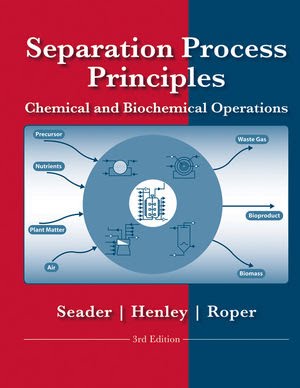
Separation Process Principles (3rd Ed.)
J.D. Seader, E.J. Henley, D.K. Roper
1 Separation Processes
1.3 Basic Separation Techniques
2 Thermodynamics of Separation Operations
2.1 Energy, Entropy, and Availability Balances
2.2 Phase Equilibria
2.3 Ideal-Gas, Ideal-Liquid-Solution Model
2.5 Nonideal Thermodynamic Property Models
2.6 Liquid Activity-Coefficient Models
3 Mass Transfer and Diffusion
3.1 Steady-State, Ordinary Molecular Diffusion
3.3 Steady- and Unsteady-State Mass Transfer Through Stationary Media
3.4 Mass Transfer in Laminar Flow
4 Single Equilibrium Stages and Flash Calculations
4.1 Gibbs Phase Rule and Degrees of Freedom
4.2 Binary Vapor-Liquid Systems
4.4 Ternary Liquid-Liquid Systems at Equilibrium
4.5 Multicomponent Flash, Bubble-Point, and Dew Point Calculations
5 Multistage Cascades and Hybrid Systems
5.2 Single Section Liquid-Liquid Extraction Cascades
6 Absorption and Stripping of Dilute Mixtures
6.1 Equipment for Vapor-Liquid Separations
6.3 Graphical Method for Trayed Towers
6.4 Kremser Group Method for Multicomponent Absorption and Stripping
6.5 Stage Efficiency and Column Height for Trayed Columns
7 Distillation of Binary Mixtures
7.1 Equipment and Design Considerations
7.2 McCabe-Thiele Graphical Method for Trayed Towers
7.3 Extensions of the McCabe-Thiele Method
7.6 Rate-Based Method for Packed Distillation Columns
7.7 Introduction to the Ponchon-Savarit Graphical Equilibrium-Stage Method for Trayed Towers
8 Liquid-Liquid Extraction with Ternary Systems
8.3 Hunter-Nash Graphical Equilibrium-Stage Method
13 Batch Distillation
13.1 Differential Distillation
13.5 Stage-by-Stage Methods for Batch Rectification
13.7 Optimal Control for Variation of Reflux Ratio
14 Membrane Separations
14.1 Membrane Materials
14.3 Mass Transfer in Membranes
15 Adsorption, Ion Exchange, Chromatography, and Electrophoresis
15.2 Equilibrium Considerations


